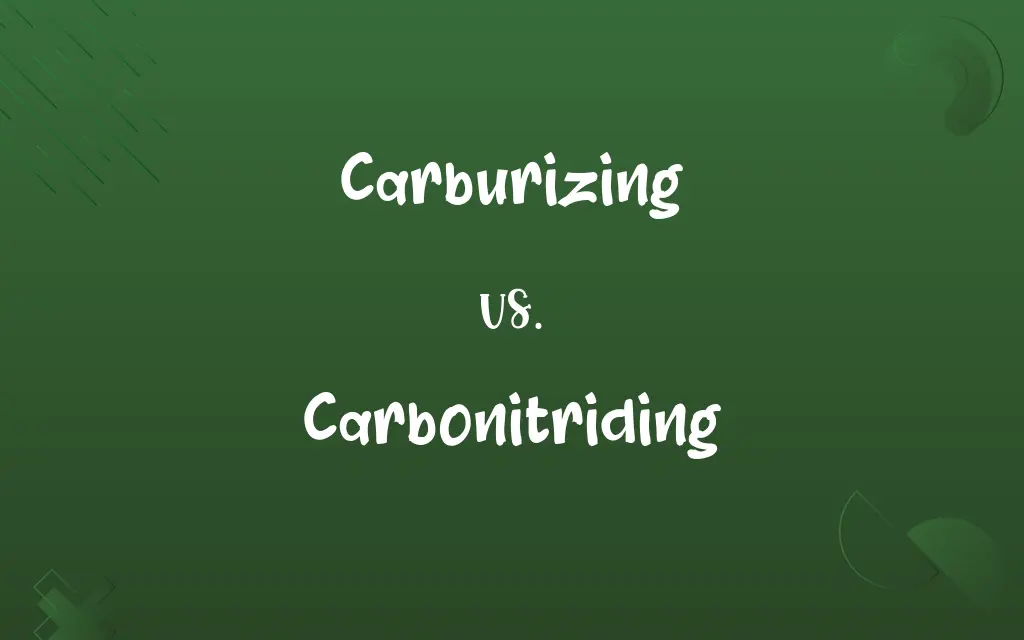Carburizing vs. Carbonitriding: Know the Difference

By Shumaila Saeed || Published on January 26, 2024
Carburizing involves adding carbon to a metal surface, while carbonitriding adds both carbon and nitrogen, affecting their depth of hardness and temperature used.

Key Differences
Carburizing is a heat treatment process that introduces carbon into the surface of a steel part. Carbonitriding, while similar, introduces both carbon and nitrogen to the metal's surface. This difference in elements used directly impacts the characteristics imparted to the metal.
Shumaila Saeed
Jan 26, 2024
Carburizing typically occurs at higher temperatures (around 900°C) and results in a deeper hardened surface. Carbonitriding is performed at lower temperatures (around 800°C) and produces a thinner, harder case than carburizing due to the presence of nitrogen.
Shumaila Saeed
Jan 26, 2024
Carburizing is best suited for low carbon steels to improve hardness and wear resistance. Carbonitriding, on the other hand, is often used for treating low alloy steels, offering enhanced surface hardness along with improved corrosion resistance and minimal dimensional changes.
Shumaila Saeed
Jan 26, 2024
The application of carburizing is common in gears, crankshafts, and other components where wear resistance is key. Carbonitriding finds its application in smaller, intricate parts requiring a hard, wear-resistant surface, such as screws and other fasteners.
Shumaila Saeed
Jan 26, 2024
Carburizing allows for greater control in adjusting the carbon gradient and depth of hardness. Carbonitriding, with the addition of nitrogen, offers more flexibility in treating components with sharp edges and complex geometries without compromising the core properties.
Shumaila Saeed
Jan 26, 2024
ADVERTISEMENT
Comparison Chart
Depth of Hardened Surface
Deeper hardness penetration
Shallower, with higher surface hardness
Shumaila Saeed
Jan 26, 2024
ADVERTISEMENT
Carburizing and Carbonitriding Definitions
Carburizing
Hardening Steel Surfaces
Carburizing the gear increased its surface hardness.
Shumaila Saeed
Jan 04, 2024
Carbonitriding
Surface Treatment
Carbonitriding was applied to improve the surface hardness of the fasteners.
Shumaila Saeed
Jan 04, 2024
Carburizing
Enhancing Toughness
Through carburizing, the crankshaft gained increased toughness.
Shumaila Saeed
Jan 04, 2024
Carbonitriding
Enhancing Resistance
The process of carbonitriding provided better corrosion resistance.
Shumaila Saeed
Jan 04, 2024
Carburizing
Adding Carbon
The process involved carburizing the steel to improve wear resistance.
Shumaila Saeed
Jan 04, 2024
ADVERTISEMENT
Carbonitriding
Hardening with Carbon and Nitrogen
Carbonitriding the screws made them more resistant to wear.
Shumaila Saeed
Jan 04, 2024
Carburizing
Heat Treatment
Carburizing at high temperatures enhances the metal's durability.
Shumaila Saeed
Jan 04, 2024
Carbonitriding
Lower Temperature Process
They used carbonitriding to treat the small metal parts.
Shumaila Saeed
Jan 04, 2024
Carburizing
Industrial Application
Carburizing is a key step in manufacturing durable machine parts.
Shumaila Saeed
Jan 04, 2024
Carbonitriding
For Intricate Parts
Carbonitriding is ideal for complex geometries needing surface hardening.
Shumaila Saeed
Jan 04, 2024
Carburizing
To treat, combine, or impregnate with carbon, as when casehardening steel.
Shumaila Saeed
Jan 04, 2024
Repeatedly Asked Queries
What is carburizing?
Carburizing is a heat treatment process adding carbon to steel surfaces to increase hardness.
Shumaila Saeed
Jan 26, 2024
What types of metals are best for carburizing?
Low carbon steels are most suitable for carburizing.
Shumaila Saeed
Jan 26, 2024
What is carbonitriding?
Carbonitriding is similar to carburizing but adds both carbon and nitrogen to the metal.
Shumaila Saeed
Jan 26, 2024
At what temperatures is carbonitriding performed?
Carbonitriding is done at lower temperatures, around 800°C.
Shumaila Saeed
Jan 26, 2024
What is the depth of hardness in carbonitriding?
Carbonitriding achieves a shallower, yet harder surface.
Shumaila Saeed
Jan 26, 2024
Is carburizing suitable for complex shapes?
Carburizing is less suitable for very intricate shapes compared to carbonitriding.
Shumaila Saeed
Jan 26, 2024
What temperatures are used in carburizing?
Carburizing typically uses temperatures around 900°C.
Shumaila Saeed
Jan 26, 2024
What metals are ideal for carbonitriding?
Carbonitriding is often used on low alloy steels.
Shumaila Saeed
Jan 26, 2024
How deep does carburizing penetrate the metal surface?
Carburizing results in a deeper hardened surface.
Shumaila Saeed
Jan 26, 2024
What are common applications of carburizing?
Carburizing is commonly used for gears and crankshafts.
Shumaila Saeed
Jan 26, 2024
Is carburizing a more flexible process than carbonitriding?
Carburizing offers more control over carbon depth but is less flexible for complex shapes.
Shumaila Saeed
Jan 26, 2024
What industries commonly use carburizing?
Automotive and machinery industries frequently use carburizing.
Shumaila Saeed
Jan 26, 2024
Does carburizing change the core properties of metal?
Carburizing mainly affects the surface, not the core properties.
Shumaila Saeed
Jan 26, 2024
Can carbonitriding treat sharp edges effectively?
Yes, carbonitriding is effective for parts with sharp edges or complex geometries.
Shumaila Saeed
Jan 26, 2024
Can both processes be used on the same metal?
It's possible, but the choice depends on the desired properties and applications.
Shumaila Saeed
Jan 26, 2024
Where is carbonitriding typically applied?
Carbonitriding is used for smaller parts like screws and fasteners.
Shumaila Saeed
Jan 26, 2024
How does carbonitriding enhance corrosion resistance?
The nitrogen in carbonitriding improves corrosion resistance.
Shumaila Saeed
Jan 26, 2024
Where is carbonitriding most commonly used?
Carbonitriding is often used in precision tool manufacturing.
Shumaila Saeed
Jan 26, 2024
Does carbonitriding affect the core of the metal?
Like carburizing, carbonitriding also primarily alters the surface.
Shumaila Saeed
Jan 26, 2024
Are carburizing and carbonitriding environmentally friendly?
Both processes have environmental impacts, but advancements are being made to reduce them.
Shumaila Saeed
Jan 26, 2024
Share this page
Link for your blog / website
HTML
Link to share via messenger
About Author
Written by
Shumaila SaeedShumaila Saeed, an expert content creator with 6 years of experience, specializes in distilling complex topics into easily digestible comparisons, shining a light on the nuances that both inform and educate readers with clarity and accuracy.








































































